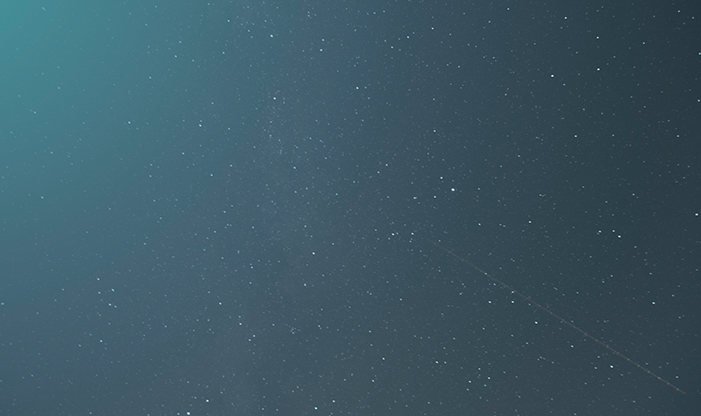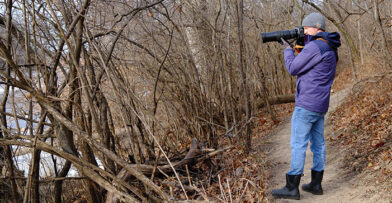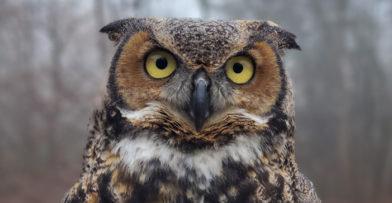Winter in Wisconsin gives us many opportunities to appreciate the quiet majesty of the night sky. Long winter nights, dry air, and bright stars provide conditions for stargazing that can’t be matched at any other time of year.
Stargazing may seem intimidating if you’re a novice, but it shouldn’t be. All you really need is curiosity, some warm winter clothes, and a clear night. Having a decent guidebook or chart, and a pair of binoculars or a telescope can also help. After that, head outside and look up!
Why Winter?
The winter solstice bestows 15 hours of darkness and a mere nine hours of daylight. The sun sets at 4:19pm on the solstice, and won’t rise again until 7:20am the next day. The math is simple – we have a lot more time in which to squeeze a few minutes outside to enjoy the sky. Peak stargazing time begins two hours after dusk, which means we can appreciate great views as early as 6:00pm instead of having to stay up as late as we would during the summertime.
Another factor that favors stargazing in winter is the earth’s location and situation in our galaxy, the Milky Way. In summer, we face the galaxy’s center during our night hours, and will consequently see the hazy light of many more stars – just like looking at the crowded lights of a big city skyline. In winter, however, we’re looking toward the outer edge of the Milky Way, where there are far fewer stars, and less light pollution. The winter sky also contains our brightest star, Sirius.
Optimal Viewing Conditions
Dry air, often considered a minus when tallying winter’s qualities, is actually a plus when it comes to visibility. Cold winter air doesn’t hold as much water vapor as warm, summer air. When present, water vapor disperses or bends light, which can affect your view of distant objects. Summer air is also prone to trapping ozone, particulate matter and other pollutants, creating haze and smog that can further distort our views of the heavens.
Of course, even in winter, viewing is not always optimal. A blizzard, large trees, and the constant glow of city lights can easily impede your view! When a clear sky beckons, consider heading to an area free of trees or above the tree line that will provide good sight lines. Once you find your site, give yourself 10 minutes to let your eyes adapt to dim light, after which you will perceive many more points of light in the sky.
Find home
One of the first things you may want to look for in the night sky is our home galaxy, the Milky Way. Comprised of between 100 billion to 400 billion stars, give or take a few, the name is inspired by the milky-white, hazy appearance of these stars when seen from Earth. The Milky Way is disk-shaped, and relatively flat, so our view looks like a glowing white ribbon arcing across our night sky.
On any clear winter evening, you can get a good view of the Milky Way, provided you have a dark enough sky. Start by finding the famous winter constellation Orion the Hunter, and then look for the milky stripe running through it.
Catch a Shooting Star
In astronomical terms, shooting stars are known as meteors, and they look like streaks of light racing across the night sky. A meteor is a small rocky or metallic body that becomes superheated as it moves through the Earth’s upper atmosphere, typically disintegrating before it hits the ground. The rare few that hit the ground are known as meteorites.
Meteors are visible on any given night, but the probability of viewing one (or several!) spikes dramatically during a meteor shower. The winter Quadrantid meteor shower is the first major meteor shower of the year. It occurs when Earth travels through a known debris field in its orbit. Peak displays should occur on the night of January 3 and during the early morning hours of January 4. For optimal viewing, look north along the horizon line until midnight, and then look higher in the sky as the night progresses into morning. People willing to brave the cold will receive a good lesson in the power of gravity while witnessing a spectacular show of shooting stars.
Sight a Planet
Sometimes a “star” you’re gazing at isn’t a star at all, but a planet. Planets don’t produce their own light, but reflect the light of the sun, just as our moon does. You can easily spot a very bright planet in early 2019 by looking east in the pre-dawn sky. If you look up on January 6 at about 45 minutes before sunrise, Venus will be at its very brightest, third in visibility after only the sun and the moon.
Witness a lunar eclipse
On January 20, the winter sky will provide us with this year’s only opportunity to witness an eclipse in the United States. It’ll be a supermoon lunar eclipse, which means the eclipse occurs when the moon is at perigee, or the point in its elliptical orbit at which it is closest to Earth. During a lunar eclipse, the sun, Earth, and the moon are perfect in alignment, and Earth blocks the sun’s rays from reaching and reflecting off the moon’s surface. While the whole event will last a little over five hours, the total eclipse will begin at 10:41pm, with maximum eclipse at 11:12pm, and end at 11:43pm.
The night sky is a continual source of fascination, with something new to offer stargazers every week. Take advantage of winter’s long nights to expand your horizons far beyond the limits of our home planet.
Written with contributions from Tom Finley, Director of Education, and Don Quintenz, Senior Ecologist.


